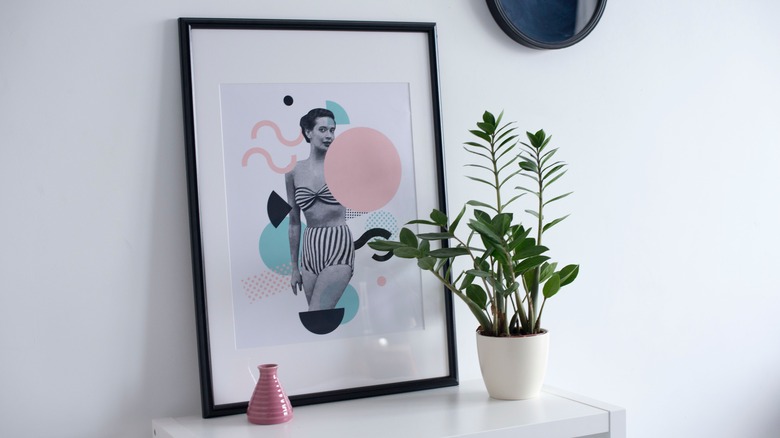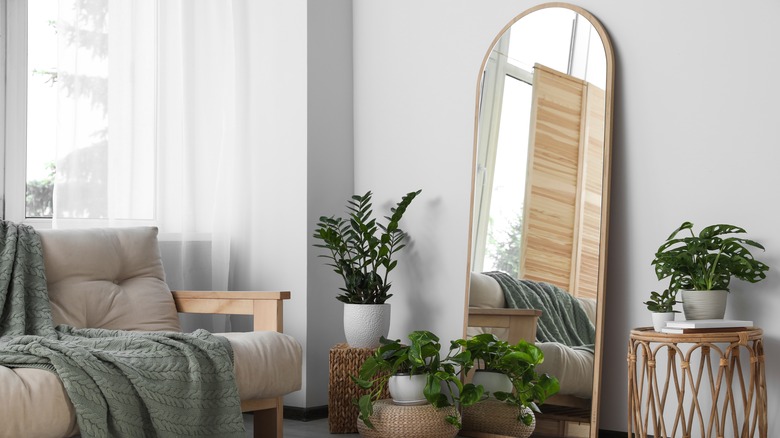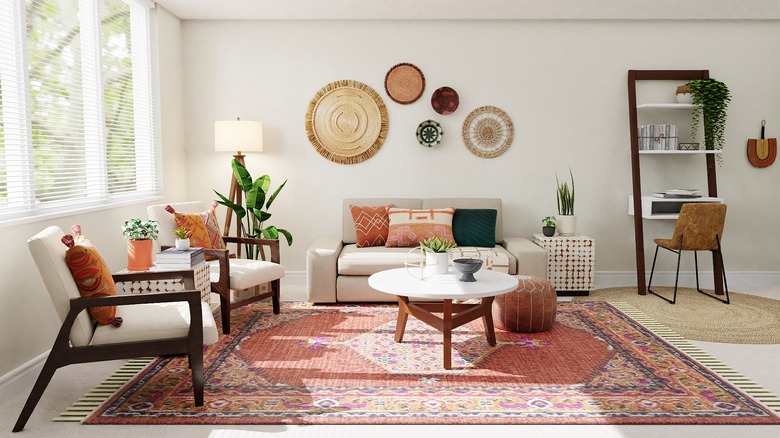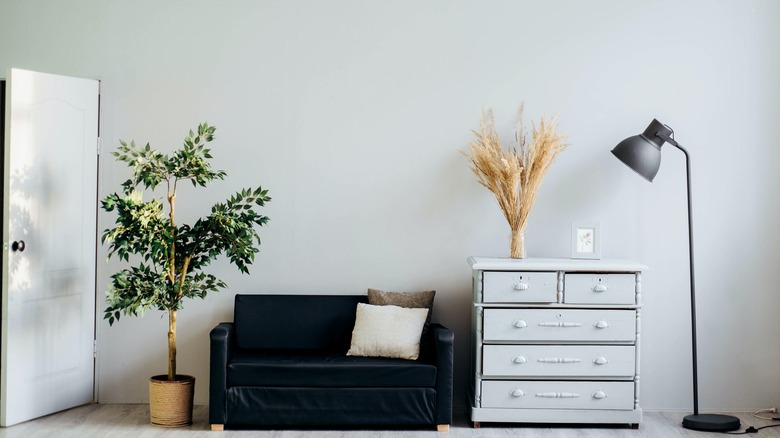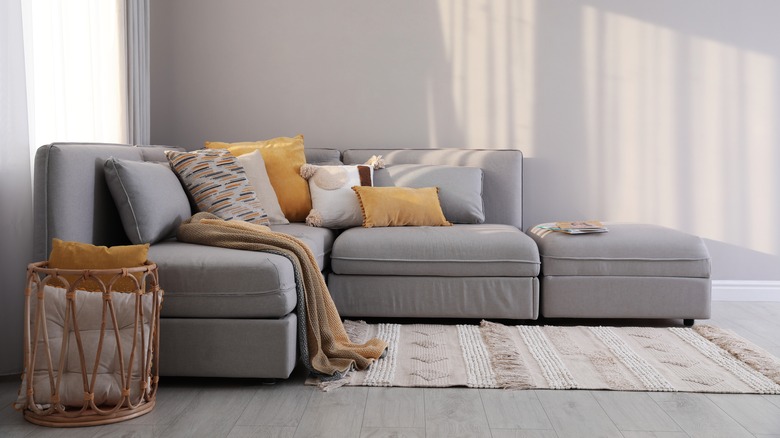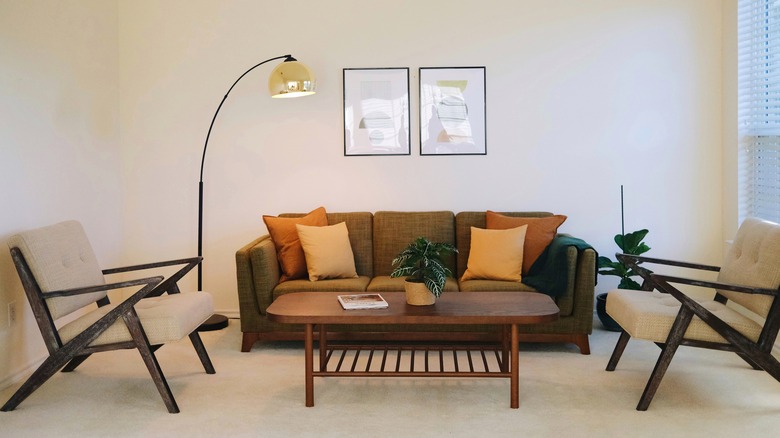How To Decorate Without Losing Your Deposit, According To An Interior Designer - Exclusive
If you rent, then you'll be well aware of how difficult it can be to inject your own style into your living space without leaving any kind of mark. It varies from landlord to landlord, but minor alterations are generally accepted, as long as the property is put back to its original state before you move out.
For this reason, semi-permanent and no-nails solutions are your best bet when decorating a rental — but if you do need to get out the toolkit, Livingetc recommends making sure that you don't carry out any changes you aren't 100% confident you've got the DIY skills to undo. Essentially, don't hammer a nail into the wall unless you're happy to fill it in, completely patch it up, and paint over it so that it leaves absolutely no trace at the end of your tenancy.
Thankfully, according to Melissa Read, founder of London-based Interior Design Studio, Studio Burntwood, it's completely possible to transform your rental in a way that your landlord will have no qualms with. In an exclusive interview with House Digest, Melissa shares her top tips and tricks for bringing some personality into your pad without risking that precious deposit.
Add leaning mirrors to your space
Far from just a way to check your outfit before heading out the door, decorating with mirrors can add both sophistication and the illusion of size to any space. But Melissa Read is keen to point out that there's no need to get out the hammer and nails and risk a disagreement with your landlord. "You may not be able to hang a mirror however, an oversized leaning mirror can give you the same impact whilst creating a relaxed, understated feel," she explains.
Giving off more of a laidback and boho look, opting to lean a mirror instead of hanging it is actually proving to be a popular decor choice among homeowners and renters alike. As well as looking great, it's essentially just a great solution for anyone who likes to frequently switch around the layout of their space and experiment with new designs.
Invest in oversized rugs
According to Melissa Read, laying an oversized area rug is a great way to give any room an immediate facelift, and set the tone for the style of the space. "Rugs can instantly add warmth to a space, whilst also hiding (potentially) dated flooring underneath," she says.
A versatile solution for renters, placing a jute rug over outdated mosaic tile flooring can help bring a tired kitchen into the 21st century, while a vintage-inspired Persian rug will add character and antique charm to any bland and soulless living space. Just make sure you've laid your rug in a way that best suits the size of the room.
Not just an attractive addition, putting down a large rug also adds a precious layer of protection between your landlord's floors and any potential spillages and stains that could see you lumped with a hefty fee. Plus, if you've got downstairs neighbors, Read points out that they'll definitely thank you for the added floor cushioning. "On a practical note, rugs are excellent noise reducers and will absorb sound, perfect for apartments or spaces with high ceilings," she says.
Paint if you can
"Color is a powerful tool when it comes to interior design," reveals Read — and we couldn't agree more. In an ideal world, landlords would understand that giving their tenants free rein with redecorating their rental makes it feel much more like home, which, in turn, makes them far more likely to stay put. But unfortunately, this just isn't typically the case.
If you've inherited a predominantly white-painted abode and you can't convince your landlord to let you do a repaint in a color of your choice, then asking whether just a new coat of the same white paint can be applied is the next best thing. "Painting is an inexpensive way to transform a space, not only will it instantly refresh a room but it can also hide imperfections in the walls and skirtings," adds Read.
And if you get the go-ahead for a refresh of the white walls, Livingetc recommends trying to stay away from the default pure white and instead going for a white shade with cool or warm undertones — these tones are far easier to work with when styling a home.
Furnish with modular furniture
While a homeowner might buy a sofa to fit a particular spot in their living room, renters need to think a little more about curating a furniture collection that can easily adapt to work wherever they next end up living. "Source key pieces that are flexible and adapt with your lifestyle," Read suggests. "Modular furniture in particular can often be easily re-upholstered and is also by nature are less hassle to handle when moving house." Plus, with singular modular units generally made to comfortably fit through a standard door, you're far less likely to end up leaving behind scrapes and smudges on the walls.
Designed to evolve with you and your ever-changing circumstances, a modular sofa might start as a two-seater squeezed into a small living room before becoming a more spacious chaise when you move somewhere with more space, and eventually ending up in your forever home as a large corner unit that's fit for the whole family.
Layer your lighting
Although lighting plays a crucial role in setting the atmosphere for any space, most landlords seem intent on sticking to basic spotlights and simple fittings wherever possible. So, Melissa Read suggests bringing in additional light sources that both showcase your interior design style and add more depth to the lighting scheme. "... although you won't be able to add or amend the existing lighting, you can still 'layer' the light with smaller and more intimate table lamps as well as large, oversized floor lamps," she says.
If you're adamant that some changes need to be made to the hardwired lighting, then simple tasks like swapping out existing ceiling pendant shades for ones that are more to your taste, and replacing bright white bulbs with warmer-toned ones, can make a big difference. But remember that you'll be left with the bill for any electrical work — so plugging in lamps, rather than fiddling with any fixtures, is a far safer bet.
